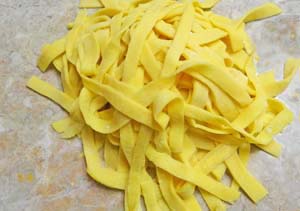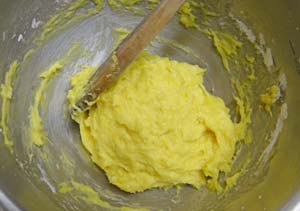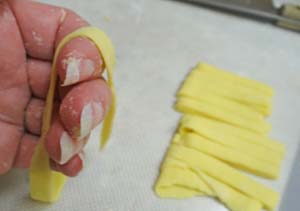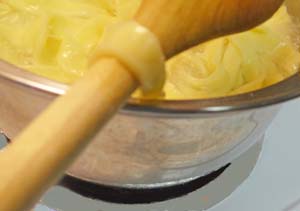You’ll be thankful for this egg pasta when you make soup, and you are able to rewarm it without the pasta becoming mushy. That’s not all. You can use it to make lasagna noodles, cannelloni, and ravioli. It holds up well, tastes spectacular, and the dough behaves. Use a pasta machine for ease, or roll by hand.
One of the things I have been missing lately is my old go-to egg noodles with gluten. In an attempt to create a gluten free egg noodles recipe, I actually created a great gluten free pasta. It does not have the flavor of eggs as gluten egg noodles do, but the texture is great! When I tried some with butter and Parmesan cheese it reminded me of the noodles in Campbell’s chicken noodle soup. Though I used cornstarch for part of this recipe, those who are intolerant to corn may wish to try tapioca starch. And for those who are potato intolerant may try substituting the potato starch with either additional cornstarch or flour/tapioca starch. Note that tapioca is chewier than potato and cornstarch.
My plan is to use a bit more cornstarch next time I make this, as corn provides more flavor than other gluten free starches. I’m also looking forward to making this in a food processor next time, but I will add extra starch directly into the bowl as it will not be needed for kneading. I’ll update the recipe below once I give it a try. In addition, I tried several different thicknesses, therefore, my photo shows it a bit too thick. Others are thinner. You’ll want to roll the dough out as thin as possible. I’ll update with a new photo next time I make this, though.
These gluten free egg noodles provide a good amount of protein, which somewhat makes up for the high starch value. Meanwhile, I hope you enjoy these gluten free egg noodles as much as my husband and I did.
Make By Hand or with Pasta Machine
i’ve made this gluten-free pasta (gluten-free egg noodles) by slicing the noodles with a knife as well as using a pasta machine. Both are very easy to do.
UPDATE: Also see my Gluten Free Spinach Pasta Recipe.

A gluten free egg noodles recipe you'd be proud to serve your gluten eating guests, made with one or two starches, a bit of gum, eggs and you're good to go!
Ingredients:
- 1/2 cup + 2 tablespoons potato starch + 2/3 cup for kneading + more for dusting
- 1/2 cup + 2 tablespoons cornstarch
- 5-1/3 teaspoons xanthan gum
- 1/4 teaspoon salt, plus more for cooking
- 4 large eggs, at room temperature
- 4-1/2 teaspoons neutral-flavored oil, plus more for boiling
- 1-1/4 cups + 1-1/3 cups for kneading + more for dusting
- 1-1/4 cups cornstarch
- 3-1/2 tablespoons xanthan gum
- 1/2 teaspoon salt, plus more for cooking
- 8 large eggs, at room temperature
- 3 tablespoons neutral-flavored oil, plus more for boiling
Instructions:
- In a large bowl, whisk together starches, xanthan gum, and salt.
- In a separate bowl, whisk together eggs and oil.
- Add egg mixture to flour mixture. Mix with a wooden spoon until dough forms.
- Transfer to a heavily starch-dusted surface or the bowl of a heavy-duty mixer fitted with a kneading attachment. Knead until dough is no longer sticky, and no seams show, 5 - 7 minutes by hand or 2 minutes using a mixer. Continue to add additional starch, as needed to prevent stickiness.
- Form dough into a log. Cut into 4 pieces (not necessarily equal). Set 3 pieces aside.
- Transfer one piece of dough to a starch-floured surface. (A silicone baking mat is ideal.) Using your fingers, flatten dough and shape into a rectangular patty.
- Using a lightly-floured rolling pin, roll out as thin as possible, less than 1/16-inch, on a starched-dusted surface. Flip the dough often and roll some more, dusting with additional potato starch as needed. (If you're using a pasta machine or roller, add starch each time you pass it through the roller. Begin with the notch on 0. Then set it a notch thinner each time you pass it through. You should be able to roll it to number 5 or 6.
- If cutting by hand, fold the dough over twice.
- Cut into 1/4-inch wide strips or 4-inches wide for lasagna noodles.
- Unfold the strips; set aside. Repeat the process with remaining sections of dough.
- Fill a large saucepan with water. Add a splash of oil to prevent sticking, and bring to a boil. Add pasta, and cook until desired tenderness, 9 - 17 minutes, depending upon thickness. Test for doneness.
- Once cooked, the water will be very starchy. Drain and rinse pasta with cold water. (This stops the pasta from cooking further and from sticking together.)
- Serve with piping hot sauce, or use in lasagna, tortellini, or cannelloni (coming soon), to name a few dishes. Another option is top with butter and Parmesan cheese and microwave until butter melts. Freeze any leftover, raw pasta in resealable sandwich bags.





Tips
Variation:
To make spinach pasta, cook 3 ounces of frozen spinach, squeeze it dry and chill completely. Add the spinach and dry ingredients to the bowl of your food processor and pulse to combine. Add the eggs and oil and pulse until dough forms. Continue with step number 5.



Could I substitute psyllium husk for the xanthan gum? My doctor told me to xanthan gum is bad for our gut lining and I need to avoid it.
Jessica,
I have not tried gum free gluten free pasta. May use add itional egg white instead of psyllium husk. Let me know how it goes.
Carla
Hello Carla,
What adjustments would you make for extruding the pasta? ( using a stand mixer attachment ).
I’v only used a rolling pasta machine and hand.
Comment from Facebook – December 21, 2015,
“Thanks! They were delicious I cooked and then added… I was out of potato
flour[starch] so I subbed tapioca starch… It was a bit extra sticky and my noodles were thick… I am looking fwd to trying it again though…. My littles inhaled.. And hubby enjoyed too.”~J.Z.D.
Facebook Comment – August 4, 2015,
“Love this recipe. I use it for ravioli aswell. The whole family loves it.”
~ H.A.P.
I’m allergic to potatoes and corn. Is there anything else you would recommend using in place of corn starch and potato starch? Only tapioca flour?
Thanks for a great recipe! My manicotti are baking now!
Help! I used cornstarch, tapioca, and xanthum gum. The dough just became increasingly more and more dry, flaky, and tough. Any suggestions? My noodles are too thick :(
I made these the other night and they were delicious. I could
not get over how easy to make. I have Celiac Sprue so this was such a treat for me. My husband is not and he went back for seconds. Thank you for sharing…. Betty
What can use instead of guar or xanthum gum?
Hi Anna,
I answered your question on Facebook, but here it is again:
you can try adding triple the amount of psylllium husk powder with additional water: http://www.amazon.com/gp/product/B00012NG1W/ref=as_li_qf_sp_asin_il_tl?ie=UTF8&camp=1789&creative=9325&creativeASIN=B00012NG1W&linkCode=as2&tag=carlasglutenfree-20
Carla
Facebook Comment – Feb. 4, 2014,
“I LOVE THESE! Made them last night. They are fabulous!! Do you think I could dry them… I had to make them all, and have leftovers, and not sure leftover noodles are all that great. So next time would have been better I think to let them sit and dry and cook later. Thanks for sharing this awesome recipe!!!!!”
~B.L.
BL,
You are very welcome! Just freeze the leftover noodles, uncooked, in individual resealable sandwich baggies. I have only recooked them once after freezing. They get a bit mushy/slimy when cooked while still frozen. So you need to cook them for a shorter time. I’ll try defrosting at room temperature next time and update the recipe.
Carla
If using these for lasagna do you boil and then layer or just layer and bake?
Mary,
I haven’tried these yet in lasagna, but I would add them in raw as they hold very well. If you do, please let us know how they turn out.
Good luck and enjoy!
Carla
Facebook Comments – Feb. 3, 2014,
“These ROCK!!”
“I make these for chicken and noodles and also for beef and noodles. I haven’t tried them by themselves. In soup I think they great!”
~K.W.
If you need corn and potato free, would using 100% tapioca starch work? or could arrowroot be substituted for cornstarch?
Mim,
Unfortunately, you cannot use all tapioca flour or arrowroot powder in this recipe. Their textures are too chewy. Sorry.
Carla
You can however, make delicious noodles using 1/2 cup tapioca and 1/2 cup arrowroot, 1/4 tsp salt, an extra egg (4 total) and 1 extra tablespoon of olive oil (2 total) and 4 tsp guar gum powder. I used these (raw) in a lasagna recipe using Daiya brand non-dairy cheese substitute. Wonderful! (and not too chewy either!)
I had to add 2T coconut flour, 3T arrowroot and 3T tapioca starch to get this to stiffen up into a dough I could handle. Either my eggs are really big, or this alteration is too wet. They did turn out okay, but I recommend putting them immediately into boiling water, or they dry out quickly and break apart.
Anita,
Coconut flour and arrowroot are too soft for this pasta recipe. Did you use those flours for the entire recipe? It is best to use the recommended starches: potato starch (not potato flour) and cornstarch.
Carla
Could these be made with an all purpose GF flour such as Jules?
Hi Dawn,
You can always give it a try; however, this pasta holds up well because it only contains starch. Jules flour as well as other all-purpose flours contain a combination of starch and other gluten-free flours.
Starch is usually less expensive than all-purpose gluten-free flour. Hopefully you will be able to pick some up and make this pasta. I think you’ll be pleasantly surprised.
Carla
My husband’s grandmother always made noodles in chicken broth for Christmas. Would these end up soggy if they were cooked in the broth and not drained? Also, would they work in a homemade chicken noodle soup? Thanks! Can’t wait to try these!
When I was a young boy, I helped my mother make egg noodles, I really miss them since I was diagnosed.
Q1, how much is 2 servings? #’s
Q2, Are you saying, cut noodles and then freeze? (do not dry, do not cook) (oh ya, I missed anything about drying)
I made a (lame) attempt last night, spent hours today cleaning my stove. lol Winter is coming so I will have more time to cook.
Thanks for having this site
Jerry
Jerry,
Great memory. Thanks for sharing it.
A1. Each serving would equal the amount that you see in the image with the cooked egg noodles. The “inside” of the bowl measures 4-inches at the bottom and 6-1/2-inches at the top.
A2. Yes. You freeze the egg noodles when they are raw. You do not need to defrost them before you cook them, either (though you may). You treat them just like fresh ravioli.
I am glad you’re enjoying my site. Thanks for letting me know.
Carla
I am a little confused… your comment said, “You freeze the egg noodles when they are raw. You do not freeze them.”
Hi Jenn,
Sorry about that. My comment is now clarified. Thanks for catching that.
Carla
Facebook Comment – Nov. 9, 2013:
“I have made these, they are fantastic!!”
~M.K.S.
Email Feedback – October 12, 2013:
“The noodles are amazing! Even when reheated! I have tried 2 other ones and these are the bomb. I am picky about my food. Thank you.”
~K.
What is the flour mixture you mention in step 3 of the instructions?
TIA, Cheryl
Cheryl,
The flour mixture in step three refers to the starches and other dry ingredients in step one.
I suppose I should change the word to starch mixture. Thanks for bringing that to my attention.
Enjoy!
Carla
What exactly is potato starch and where do you get it?
Hi Lisa,
Per Wikipedia, “Potato starch is starch extracted from potatoes. The cells of the root tubers of the potato plant contain starch grains (leucoplasts). To extract the starch, the potatoes are crushed; the starch grains are released from the destroyed cells. The starch is then washed out and dried to powder.” You can purchase it in my store: http://glutenfreerecipebox.com/store/(probably around page 8 in the Pantry section) or in stores that sell Bob’s Red Mill products.
I hope this helps.
Carla
I am new to gluten free. I’ve noticed that in most gluten free recipes I have seen, they have eggs and also xanthan gum or agar agar. What is the purpose in using both? And in recipes that just call for xanthan gum or agar agar, is it ok to just use a flax seed swirl, and how much flax seed should be used, would it always be 1 Tablespoon?
Love your site! It is answering questions I’ve had.
MJ
Hi Maryjane,
The purpose of using xanthan gum, guar gum, gum arabic, other gums, and agar agar in recipes is to hold the ingredients together. Gums are the best substitute for gluten. They provide a bit of a chewy texture and make baked goods such as breads pliable. Eggs hold ingredients somewhat, but eggs have several different purposes. They provide moisture and rise, as well.
To discover the recipe for flax swirl (warm water and flax seed meal) and other gluten free egg substitutes visit http://glutenfreerecipebox.com/gluten-free-egg-substitute/. There I list all of the ones I have come across. The tapioca gel seems to have the best reviews.
I’m so glad to hear my site is helping you.
Carla
Can i make these only using corn starch and ommiting the gum? Thank you!
Odalis,
Using one starch should not be a problem. Ommitting the gum may work, as well, since there are so many eggs in this recipe. Let me know how it turns out. Though I would not suggest using a pasta roller/machine without the gum.
Good luck and enjoy!
Carla
I used this to make spaetzels for chicken paprikash…. yes finally… made it extra thick (more potato starch) and I also had to use arrow root in place of xanthan (because I ran out). I made it stiff thick and I even added fresh parsley to the mix of part of it for more flavor.
SO SO HAPPY. I cannot eat tapioca, wheat, spelt, aramanth, any animal milk or gluten. Used tofutti sour cream mixed with lemon juice for the sour cream part (makes it more tart and sour cream tasting) and used Olivio coconut butter and also light olive oil. SO SO SO HAPPY, DID I MENTION THAT I AM HAPPY??
Gina,
You made me happy, too! Thank you for sharing your success!
Carla
Can you use this recipe in a pasta maker machine?
Hi Laurie,
I have only made this pasta once, therefore, cannot say for sure, but because the dough is so easy to handle, I do not think you will have any problem at all “rolling” this through a machine. I would not, however, use this in a tube-like machine such as the older version of the KitchenAid pasta attachment with the food feeder.
Please let us all know how it goes.
Carla
I am anxious to try these… I miss noodles! I have really come to like the Quinoa/cornstarch pastas as they are very tasty, even the day after, but noodles… yippeee!
I was thinking of trying this recipe to make ravioli, what do you think? Thought I’d try cutting out circles or squares from the dough and putting some cooked ground meat in. Thanks for the tip on reheating the pasta with butter/margaine in the microwave as we are gluten/dairy/tomato free here, so hot pasta sauces are hard to come by (cold pasta + cold sauce = yuck!)
Hi Kim!
I have a ravioli a gluten-free ravioli recipe: http://glutenfreerecipebox.com/gluten-free-basil-cream-sauce/, however, I would definitely this give this dough a try. I was thinking of using it myself.
Being allergic to tomatoes myself, I can understand about sauces. Here’s one of my favorite sauces: http://glutenfreerecipebox.com/gluten-free-ravioli/.
If you need to find a recipe just use the search box in the top right-hand corner of most pages, or leave a comment for me and I’ll direct you if, I have it.
Nice of you to stop by!
Carla
Would these work in a chicken noodle soup or would the noodles just sog and fall apart?
Hi Suzanne,
These work very well in chicken noodle soup. See my chicken noodle soup recipe here: http://glutenfreerecipebox.com/gluten-free-chicken-noodle-soup/ Because they made from all starch they are much sturdier than other gluten free pastas. However, when I make soup, even when I made glutenous soup, I usually add the noodles to a bowl and then and then add the soup. It should hold up in a thermos from morning to afternoon, though. Enjoy! I haven’t tried it though.
Carla
Can these noodles be dried or frozen for later use?
Debra,
I would give a few pieces a try in the freezer, as pasta usually freezes very well. You may need to dust the pieces with flour or starch to prevent from sticking to one another. I would not try drying them since they contain fresh egg. Please let us all known how it works out.
I hope you enjoy!
Carla